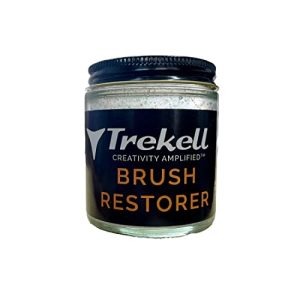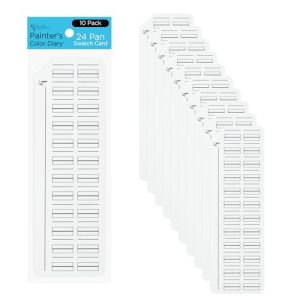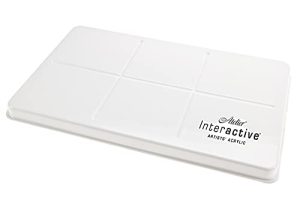How To remove acrylic paint from clothes, act quickly. Rinse the stain with cold water and apply liquid detergent.
Acrylic paint stains can be stubborn, but with prompt action, you can save your favorite garments. Acrylic paint is water-based, making it easier to remove while still wet. Start by rinsing the stained area with cold water to flush out as much paint as possible.
Apply a liquid detergent directly to the stain and gently rub it with your fingers or a soft brush. Let it sit for a few minutes before rinsing again. Repeat the process if necessary. For dried paint, use rubbing alcohol or a commercial stain remover to break down the paint before washing. Acting fast increases the chances of complete stain removal.
:max_bytes(150000):strip_icc()/how-to-get-acrylic-paint-off-clothes-5323500-03-fa971e86103245c0bf76300b5f9334b0.jpg)
Credit: www.thespruce.com
Introduction To Acrylic Paint Mishaps
Acrylic paint is fun but can be messy. It dries fast and sticks well. These qualities make it tough to remove from clothes. This guide helps you deal with such mishaps.
The Challenge Of Acrylic Stains
Acrylic paint dries quickly. Once dry, it becomes water-resistant. This makes it hard to clean. Regular washing won’t work. Stains need special attention.
Immediate Action: First Step To Success
Act fast to remove wet paint. Blot the stain with a paper towel. Avoid rubbing to prevent spreading. Use cold water to rinse the stain. Do not use hot water.
| Step | Action |
|---|---|
| 1 | Blot the stain with a paper towel |
| 2 | Rinse with cold water |
| 3 | Apply mild soap |
| 4 | Scrub gently with a toothbrush |
| 5 | Rinse and repeat if necessary |
Use mild soap for better results. Rub gently with an old toothbrush. Rinse and repeat if needed. This method works best on fresh stains.
Pre-treatment Tactics
Accidents happen, and getting acrylic paint on clothes is common. Removing acrylic paint from fabric requires effective pre-treatment tactics. These steps can save your favorite shirt or pants.
Identifying Fabric Type
Knowing your fabric type is crucial. Different fabrics react differently to cleaning agents. Common fabric types include cotton, polyester, wool, and silk.
| Fabric Type | Reaction to Cleaning Agents |
|---|---|
| Cotton | Handles most cleaning agents well |
| Polyester | Can be sensitive to harsh chemicals |
| Wool | Requires gentle cleaning agents |
| Silk | Very delicate, use mild detergents |
Spot Testing: A Crucial Measure
Spot testing prevents damage to your fabric. Always test a small, hidden area first. Use a cotton swab with the cleaning agent. Apply it to the hidden spot and wait for 10 minutes. Check for any discoloration or fabric damage.
- Pick a hidden area of the fabric.
- Use a cotton swab and cleaning agent.
- Apply and wait for 10 minutes.
- Check for any discoloration or damage.
If the test spot looks fine, proceed with cleaning the stained area. Spot testing is a simple but crucial step to ensure fabric safety.
Common Household Solutions
Accidents happen, and acrylic paint on clothes is no exception. But don’t worry, you can tackle this mess with common household solutions. In this section, we’ll explore some effective methods using items you probably already have at home.
Leveraging Dish Soap Power
Dish soap isn’t just for dishes. It can help remove acrylic paint from clothes too. Here’s how:
- Blot the stain with a paper towel to remove excess paint.
- Rinse the stained area with cold water. Aim from the back of the fabric.
- Apply a few drops of dish soap to the stain.
- Use a soft brush or sponge to gently scrub the area.
- Rinse with cold water and repeat if needed.
- Wash the garment in the washing machine.
The Magic Of Vinegar And Baking Soda
Vinegar and baking soda are a dynamic duo in cleaning. They can work wonders on acrylic paint stains. Follow these steps:
- Start by blotting the stain with a paper towel to remove excess paint.
- Mix equal parts of vinegar and water in a bowl.
- Soak the stained area in the vinegar solution for about an hour.
- Sprinkle baking soda directly onto the stain.
- Use a soft brush to scrub the baking soda into the fabric.
- Rinse with cold water and repeat if necessary.
- Finish by washing the garment in the washing machine.
These common household solutions can save your favorite clothes. Give them a try next time you find yourself in a sticky, paint-covered situation.
Specialized Stain Removers
Accidents happen, and acrylic paint spills on clothes are common. Using specialized stain removers can save your favorite shirt or pants. These products are designed to break down paint particles effectively.
Choosing The Right Product
Not all stain removers are the same. Choose one specifically for acrylic paint. Look for products labeled as paint removers or multi-purpose stain removers.
| Product | Suitable For |
|---|---|
| OxiClean MaxForce | All fabrics |
| Goof Off Paint Remover | Heavy-duty stains |
| Grandma’s Secret Spot Remover | Delicate fabrics |
Application Techniques For Optimal Results
Proper application ensures maximum stain removal. Follow these steps for best results:
- Read the product’s instructions carefully.
- Test on a small hidden area first.
- Apply the remover directly on the stain.
- Use a soft brush to gently scrub the area.
- Rinse with cold water and check the stain.
- Repeat if necessary, then wash as usual.
Some products may need longer to work. Patience is key. Always ensure proper ventilation when using chemical-based removers.
Specialized stain removers can make a big difference. They help maintain your clothes’ look and feel.
Mechanical Methods
Removing acrylic paint from clothes can be a challenging task. Mechanical methods offer effective ways to tackle this problem. These methods involve physical actions to break down and lift the paint. Let’s explore some effective techniques.
Gentle Brushing Techniques
Gentle brushing techniques help to loosen dried paint. Use a soft-bristled brush to avoid damaging the fabric. Move the brush in small, circular motions over the paint stain.
For delicate fabrics, use a toothbrush. Apply light pressure to avoid tearing. Always brush in one direction to lift the paint effectively. Repeat the process until most of the paint is removed.
The Role Of Absorbent Materials
Absorbent materials play a crucial role in removing paint. Blot the stain with a paper towel to absorb excess paint. Use a clean cloth or sponge for better results.
Place a thick cloth under the stained area. This prevents the paint from spreading. Continue blotting until no more paint transfers to the cloth.
For stubborn stains, sprinkle baking soda over the stain. It helps absorb the paint. Let it sit for a few minutes before brushing it off.
Here is a quick summary of the steps:
| Step | Action |
|---|---|
| 1 | Brush with soft bristles |
| 2 | Use absorbent materials |
| 3 | Blot with a clean cloth |
| 4 | Sprinkle baking soda |
These simple mechanical methods can save your clothes. They are easy to follow and effective.

Credit: feelingnifty.com
Washing Machine Wisdom
Accidentally getting acrylic paint on clothes can be frustrating. Your washing machine can help. This section explores how to use your washing machine to remove acrylic paint.
Selecting The Proper Cycle
Choosing the right cycle is crucial. Acrylic paint stains need a delicate yet thorough wash.
- Cold Wash: Use cold water. Hot water sets the paint.
- Gentle Cycle: Opt for a gentle cycle to avoid fabric damage.
- Extended Rinse: Select an extra rinse to remove paint residues.
Detergents And Boosters
Detergent choice matters in paint removal. Use the right products for the best results.
| Product | Usage |
|---|---|
| Liquid Detergent | Effective for pre-treating stains. Apply directly on the paint spot. |
| Stain Remover | Boosts detergent power. Spray on the stain before washing. |
| Oxygen Bleach | Safe for colors. Add to the wash cycle for stubborn stains. |
Follow these steps for the best results:
- Pre-treat the paint spot with liquid detergent.
- Spray a stain remover on the affected area.
- Add oxygen bleach to the detergent compartment.
- Set the washing machine to a cold, gentle cycle.
- Run an extended rinse to ensure all paint is removed.
Post-wash Inspection And Treatment
After washing your clothes, it’s crucial to inspect them thoroughly. This step ensures that the acrylic paint stains have been effectively removed. If you find any remaining stains, don’t worry. Follow these steps to tackle them efficiently.
Evaluating Stain Removal
Carefully examine the washed clothes in bright light. Look for any spots where the acrylic paint may still be visible. Pay attention to the edges and seams of the fabric.
- Check the front and back of the stained area.
- Feel the fabric to detect any roughness caused by dried paint.
- Use a magnifying glass for better inspection of stubborn stains.
Secondary Treatments If Necessary
If the stain persists, use secondary treatments. These methods can help remove leftover acrylic paint.
- Alcohol-Based Solutions: Apply rubbing alcohol on a cotton ball and dab the stain gently.
- Vinegar and Baking Soda: Mix vinegar and baking soda to form a paste. Apply it to the stain and let it sit for 15 minutes.
- Nail Polish Remover: Use a small amount of non-acetone nail polish remover on a cloth and blot the stain.
Rinse the treated area thoroughly after applying these solutions. Repeat the washing process if needed.
| Solution | Application Method | Duration |
|---|---|---|
| Rubbing Alcohol | Apply with cotton ball | 5-10 minutes |
| Vinegar and Baking Soda | Form a paste and apply | 15 minutes |
| Non-Acetone Nail Polish Remover | Blot with cloth | 5-10 minutes |
Inspect the clothes again after these treatments. Ensure no paint traces are left. Repeat the process if necessary.

Credit: www.youtube.com
Prevention And Care Tips
Accidents happen, but you can prevent and care for clothes during and after painting. Here are some tips to keep your clothes safe.
Protective Measures During Painting
Protecting clothes while painting is essential. Here are some easy steps:
- Wear old clothes: Use clothes you don’t mind getting dirty.
- Use aprons or smocks: Cover your clothes with an apron.
- Lay down drop cloths: Protect the area around you with cloths.
- Keep wipes handy: Clean spills quickly with wet wipes.
These measures help keep your clothes paint-free and make clean-up easier.
Maintaining Clothes Post-paint Removal
After removing paint, take care of your clothes to keep them in good shape:
- Rinse thoroughly: Rinse the area with cold water.
- Use stain remover: Apply a stain remover to the spot.
- Wash immediately: Wash the item in the washing machine right away.
- Check before drying: Ensure the paint is gone before drying.
Follow these steps to maintain the quality of your clothes after a paint mishap.
Frequently Asked Questions
How Do You Get Dried Acrylic Paint Out Of Clothes?
Scrape off excess paint. Soak the stain in warm, soapy water. Apply rubbing alcohol. Gently scrub with a toothbrush. Rinse and repeat if needed.
Is Acrylic Paint Permanent On Clothes?
Acrylic paint can be permanent on clothes if properly sealed. Use a fabric medium and heat-set the paint for best results.
Will Oxiclean Remove Acrylic Paint From Clothes?
OxiClean can help remove acrylic paint from clothes. Pre-treat the stain and launder as usual for best results.
Does Vinegar Remove Paint From Clothing?
Yes, vinegar can help remove paint from clothing. Apply vinegar, let it sit, then scrub gently. Rinse thoroughly.
How Do You Remove Acrylic Paint Stains?
Blot paint with paper towels. Apply dish soap and water. Rub gently until the stain lifts.
Can Vinegar Remove Acrylic Paint From Clothes?
Yes, vinegar helps loosen acrylic paint. Soak stained area in vinegar, then scrub gently with a brush.
Is Acrylic Paint Permanent On Fabric?
Acrylic paint is semi-permanent. Quick action with soap and water can help remove it from fabric.
What Home Remedy Removes Acrylic Paint?
Rubbing alcohol is effective. Dab it on the stain, let it sit, then scrub gently.
Conclusion
How to Removing acrylic paint from clothes can be simple with the right techniques. Act quickly and use household items like dish soap or rubbing alcohol. Pre-treat the stain and wash as usual. These steps will help keep your clothes looking their best, saving both time and money.
Happy cleaning!




